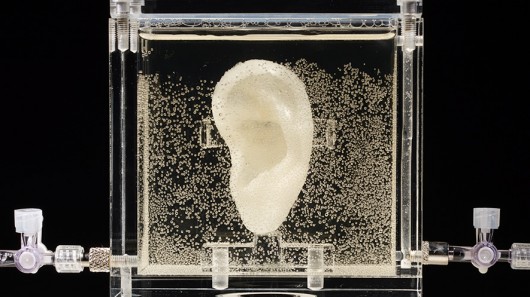
 If
you thought cloning mice, frogs and extinct mammoths to be challenging, how
about cloning Vincent Van Gogh's ear? Dutch artist Diemut Strebe has grown a
living replica of the ear that Vincent Van Gogh reportedly sliced off in a
troubled episode, using genetic material from one of Van Gogh's direct descendants.
With a lifespan of 80 years or more, the ear could live as long as any one of
us, says Strebe, who is investigating the idea of replicating people from
historical DNA.
If
you thought cloning mice, frogs and extinct mammoths to be challenging, how
about cloning Vincent Van Gogh's ear? Dutch artist Diemut Strebe has grown a
living replica of the ear that Vincent Van Gogh reportedly sliced off in a
troubled episode, using genetic material from one of Van Gogh's direct descendants.
With a lifespan of 80 years or more, the ear could live as long as any one of
us, says Strebe, who is investigating the idea of replicating people from
historical DNA.
"The
ear is grown with Lieuwe van Gogh's cells," Strebe tells Gizmag. "By
his natural relationship to Vincent, he carries in his cells the white
chromosomes of Vincent and a 16th of his genome."
Strebe
figured out the shape of the ear by looking at a historical photo of the
artist, and extrapolated the measurements to create a 3D-printed mold that
approximated its shape. A scaffold placed in the mold was seeded with Van
Gogh's cells, which grew until the ear reached its final form. The result,
states Strebe, is a true living piece.
"It
has a metabolism," Strebe tells us. "It lives in a container, in a
system which mimics our body. It has a lung, it has a heart, it has plasma and
it even has oxygen exchange."
To
make a system that supported the ear, she built a bioreactor that mimics the
body's different parts. According to Strebe, the ear could live to be really
old if it's well taken care of and given proper nutrition. To genetically
engineer the ear to be as close to Vincen't Van Gogh's as possible, she
collaborated with scientists at Harvard and MIT as part of a project called "Sugababe."
Along with some of Van Gogh's genetic material, the ear is also made up of some
genetically engineered components.
While
she initially hoped to use Van Gogh's own DNA to grow the ear, that plan fell
apart when donated letters that supposedly belonged to the artist (which took a
year for her to source) were found to lack any trace of his DNA. Strebe next
approached Lieuwe van Gogh, the great-great-grandson of Vincent's brother Theo
Gogh, who readily donated a bit of his skin for the project. Strebe, who is
currently trying to source other historical DNA to experiment with, says that
the project brings up many interesting questions about human replication.
"Theoretically
a historical person could be genetically created," Strebe tells us."
There are many interesting questions involved about uniqueness, about the
possibility to reconstruct somebody physically or how identical the result
would be even if you get to that point. The questions involved are similar to
those when Plutarch talked about the Ship of Thesus – whether a ship would be
the same ship if all its parts were replaced?".
The
living ear was exhibited recently at the Center for Art and Media (ZKM) in
Karlsruhe, Germany.

 Previous page
Previous page Back to top
Back to top







